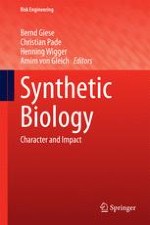2015 | OriginalPaper | Buchkapitel
Protein Tectons in Synthetic Biology
The Expansion of Cellular Functionality Combining Chemical Biology of Small Organic Molecules with Protein Tectons—Unnatural Amino Acids, Protein Based Biohybrid Materials and De Novo Organelles
verfasst von : Stefan M. Schiller
Erschienen in: Synthetic Biology
Aktivieren Sie unsere intelligente Suche, um passende Fachinhalte oder Patente zu finden.
Wählen Sie Textabschnitte aus um mit Künstlicher Intelligenz passenden Patente zu finden. powered by
Markieren Sie Textabschnitte, um KI-gestützt weitere passende Inhalte zu finden. powered by
